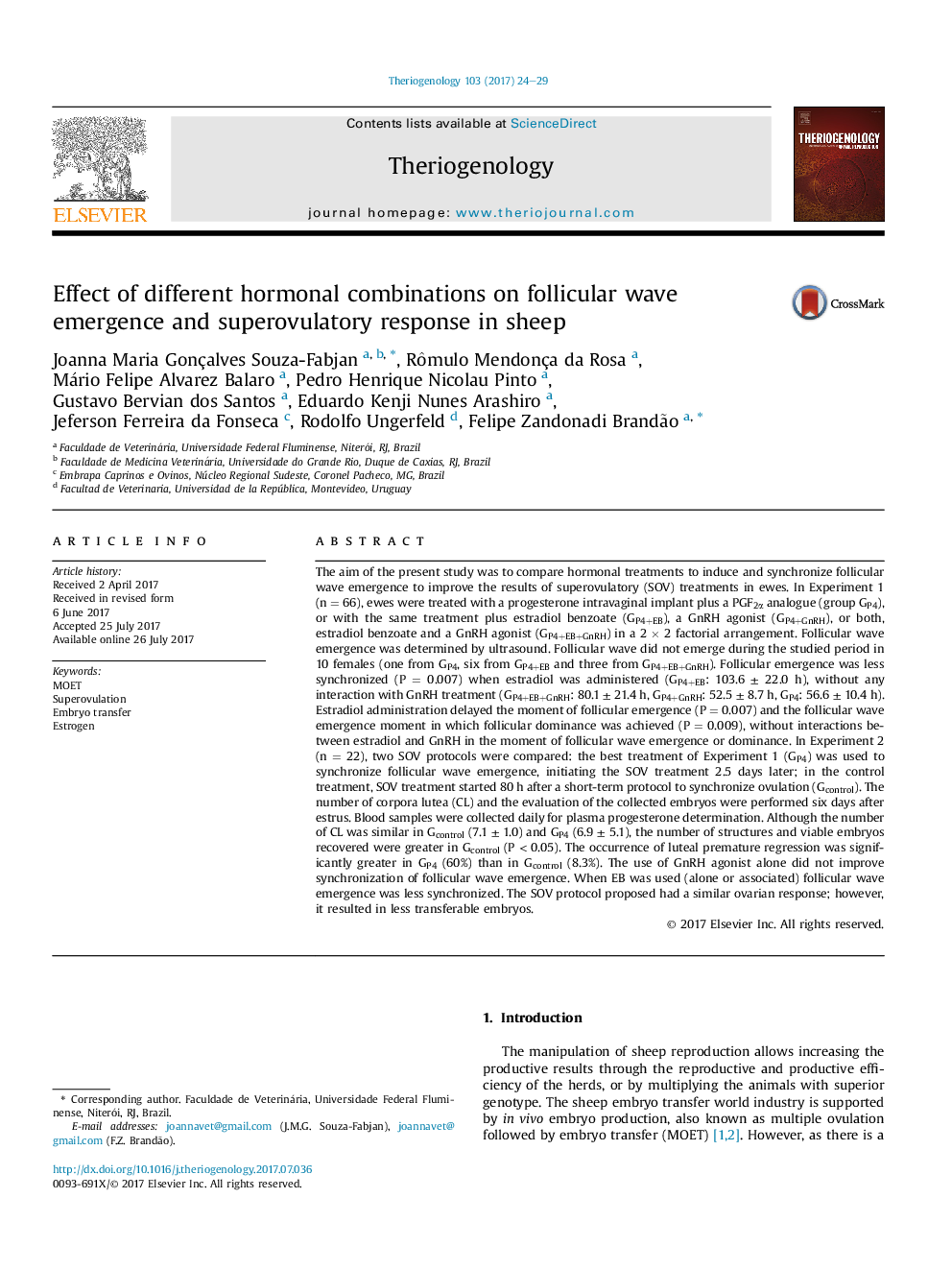| کد مقاله | کد نشریه | سال انتشار | مقاله انگلیسی | نسخه تمام متن |
|---|---|---|---|---|
| 5522898 | 1546066 | 2017 | 6 صفحه PDF | دانلود رایگان |
- P4 alone was enough to synchronize follicular wave emergence in ewe.
- GnRH agonist alone did not improve synchronization of follicular wave emergence.
- Estradiol benzoate delayed the emergence of follicular wave.
- SOV after synchronized follicular wave emergence did not affect ovarian response.
- SOV after synchronized wave emergence resulted in poorer embryo recovery rate.
The aim of the present study was to compare hormonal treatments to induce and synchronize follicular wave emergence to improve the results of superovulatory (SOV) treatments in ewes. In Experiment 1 (n = 66), ewes were treated with a progesterone intravaginal implant plus a PGF2α analogue (group GP4), or with the same treatment plus estradiol benzoate (GP4+EB), a GnRH agonist (GP4+GnRH), or both, estradiol benzoate and a GnRH agonist (GP4+EB+GnRH) in a 2 Ã 2 factorial arrangement. Follicular wave emergence was determined by ultrasound. Follicular wave did not emerge during the studied period in 10 females (one from GP4, six from GP4+EB and three from GP4+EB+GnRH). Follicular emergence was less synchronized (P = 0.007) when estradiol was administered (GP4+EB: 103.6 ± 22.0 h), without any interaction with GnRH treatment (GP4+EB+GnRH: 80.1 ± 21.4 h, GP4+GnRH: 52.5 ± 8.7 h, GP4: 56.6 ± 10.4 h). Estradiol administration delayed the moment of follicular emergence (P = 0.007) and the follicular wave emergence moment in which follicular dominance was achieved (P = 0.009), without interactions between estradiol and GnRH in the moment of follicular wave emergence or dominance. In Experiment 2 (n = 22), two SOV protocols were compared: the best treatment of Experiment 1 (GP4) was used to synchronize follicular wave emergence, initiating the SOV treatment 2.5 days later; in the control treatment, SOV treatment started 80 h after a short-term protocol to synchronize ovulation (Gcontrol). The number of corpora lutea (CL) and the evaluation of the collected embryos were performed six days after estrus. Blood samples were collected daily for plasma progesterone determination. Although the number of CL was similar in Gcontrol (7.1 ± 1.0) and GP4 (6.9 ± 5.1), the number of structures and viable embryos recovered were greater in Gcontrol (P < 0.05). The occurrence of luteal premature regression was significantly greater in GP4 (60%) than in Gcontrol (8.3%). The use of GnRH agonist alone did not improve synchronization of follicular wave emergence. When EB was used (alone or associated) follicular wave emergence was less synchronized. The SOV protocol proposed had a similar ovarian response; however, it resulted in less transferable embryos.
Journal: Theriogenology - Volume 103, November 2017, Pages 24-29
